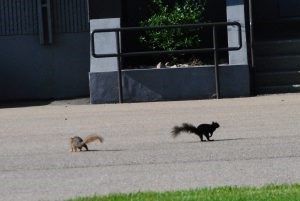This content was originally published by the Longmont Observer and is licensed under a Creative Commons license.
Lately, I’ve been noticing black squirrels running around in addition to the brown squirrels I usually see. Is this a new species or an invasive species run amok? Turns out it is just a squirrel of a different color. Fox squirrel that is. These black squirrels are actually fox squirrels with lots of melanin due to a particular type of gene. This gene is also responsible for black panthers and black wolves. Melanin is a pigment found in the hair, skin, and the eye irises, and is responsible for freckles. It is the reverse of albinism which produces pure white animals.
Colorado is home to three types of squirrels, but only one species occurs down here on the plains.

As you would guess, fox squirrels spend most of their time in trees and therefore they are called an arboreal species. They have long, curved claws and extensive muscles in their forearms and stomach which accounts for the array of acrobatics they are capable of performing. They even have an adaptation that allows them to turn their feet 180 degrees. Fox squirrels can run up to 15 miles per hour. In urban areas, fox squirrels prefer areas with a variety of tree types, but they can also be seen eating from bird feeders. More on that later.
Fox squirrels mate twice a year, having litters in the spring and in the summer. Females may mate with more than one male, but the males will compete with each other for mating rights. Males will adopt an aggressive upright stance with the tail over the back. This is usually preceded or followed by a tail flick and the aggressor rapidly approaching his competition. The female is in heat only one day per breeding season.
Litters are born in dens that are built in natural tree cavities or in leaf nests called dreys. Dens are preferred over the leaf nests, but fox squirrels may use multiple dens or nests. Gestation lasts about 45 days and a typical litter consists of two or three young although up to seven may be born. The female raises the young alone.
Pups are born completely helpless and naked. Their ears are closed and don’t open until about week three, around the same time their teeth start to come in. Their eyes don’t open until about five weeks after birth. Females wean their young at about eight weeks. When the mother leaves the nest while the young are still present, she covers the pups with nesting material. The young get their adult coat of fur when they are around three months old, around the time they become independent.
Although tree seeds comprise the bulk of the fox squirrel’s diet throughout the year, fox squirrels are quite versatile. During the winter and the spring they make use of tree buds and flowers. During the summer, squirrels will also eat fruits. Insects may also be eaten. On farms squirrels will eat corn. As mentioned earlier, fox squirrels are year-round visitors to backyard bird feeders. Squirrels will cache their food by burying it in the ground, finding it in the winter by using their incredible sense of smell. Buried food that is not found and ends up producing new trees making fox squirrels an important part of the ecosystem. Squirrels find anywhere from 33% to 99% of their cached food.
Many an avid backyard birder has been thwarted by the fox squirrel eating at their bird feeders. Some have come up with inventive ways to foil the wily critters. One solution is to put a slinky around the pole for the bird feeder. The squirrels will try to jump to the pole and promptly be deposited at the bottom. Some birders swear that switching to feeding safflowers, niger thistle, and white millet will continue to attract all the same birds, while keeping squirrels away because they don’t like the food. Experts also suggest mounting feeders that hang in trees at least eight feet from the trunk to force squirrels to climb down onto the feeder. A cone shaped dome over the feeder can then be used to help keep the squirrels out. There are other methods such as using capsaicin, the active ingredient in hot peppers, and electricity to keep squirrels away, but the Humane Society does not recommend these if other methods can work. You can offer squirrels feed in a separate feeder, but squirrels can’t distinguish between what is “their” food and what is not. You may need to try a combination of methods. The bottom line is that squirrels are smart and creative and at the end of the day, you may just have to join them if you can’t beat them.



